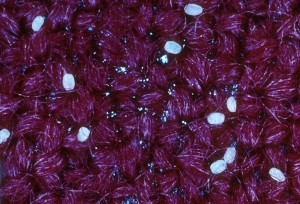What Are Moth Eggs?
Moth eggs are extremely small and barely visible to the naked eye. In most cases, when you think you’ve spotted moth eggs, it’s actually the excrement of moth larvae you're seeing.
Note: This article is exclusively about eggs from house moths (i.e., moths that thrive in our homes and are considered pests) and not the other 160,000 species of moths that exist!
Quick Facts
- Size: Moth eggs are very small (less than 1 mm) and difficult to see with the naked eye.
- Number: Moths can lay between 40 and 600 eggs in their lifetime, depending on the species.
- Egg-laying: Most moths lay their eggs immediately after emerging from the pupa (i.e., as soon as they are fully grown).
- Locations: Moths commonly lay eggs in clothes stored in closets and drawers, household textiles, and dry foods in kitchen cabinets.
- Elimination: Moth eggs, larvae, and adult moths cannot survive machine washing, dry cleaning, freezing (-18°C), or heating (+50°C).
What Do Moth Eggs Look Like?
Moth eggs are very small (less than 1 mm in length and width), making them hard to see with the naked eye. In most cases, you’ll need a magnifying glass to see them.
The eggs are whitish or slightly yellow in color and resemble the shape of round grains of rice, like those used for porridge or risotto. However, their tiny size makes it nearly impossible to confuse them with actual rice grains (you can barely see them!).
Moth eggs are extremely small and difficult to see with the naked eye – they are often well hidden in textiles or food
When you think you've spotted moth eggs, it’s almost always the excrement of moth larvae. Larvae droppings are larger and often found in more accessible places, making them more visible than the eggs.
Where Do Moths Lay Their Eggs?
Adult moths lay their eggs on what will be food for their offspring. This allows the newly hatched larvae to start feeding on the material they are born on.
What each larva can eat depends on its species. However, food scarcity and availability can also play a role. For example, a moth species that typically feeds on organic textiles might lay its eggs on a synthetic jacket lined with feathers. After hatching, the larvae will gnaw through the synthetic material to reach the feathers, which are organic. Similarly, eggs may be laid in a sweater made of a wool-cotton blend, which the larvae can easily live on.
In a typical home, moths lay their eggs in two places:
- In textiles
- In dry foods
In addition, the brown house moth may also lay eggs in plant materials and certain animal materials around the home and is often found in places like bird nests.
| Moth species | Image | Larvae food sources | Typical larvae food | Typical egg laying locations |
| Clothes moth | 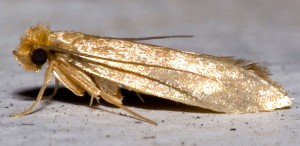 |
Organic textiles and possibly also synthetics or plant textiles | Wool, silk, feathers and down, but also blended and unclean textiles | Textiles in cabinets, drawers, bags, boxes, etc. and home textiles |
| Case-bearing clothes moth | 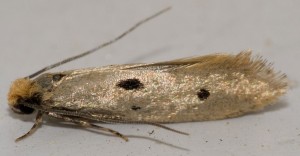 |
Organic textiles and dry food | Especially fur, feathers and down, but also silk, wool, etc. as well as dry foods such as seeds, spices, tea, etc. | Textiles in cabinets, drawers, bags, boxes, etc. as well as home textiles and kitchen cabinets |
| Brown house moth | 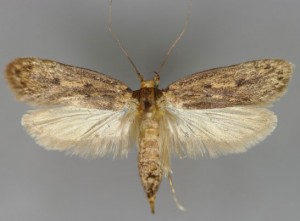 |
Organic textiles, plant materials and certain animal materials | Wool, fur, seeds, grains, grains, cork, dried plants, bird nests and more, but also leather, skins, animal feed, dead insects and the like. | Wardrobes, kitchen cabinets, utility rooms, garages, basements, attics, gardens and more. |
| Indian meal moth | 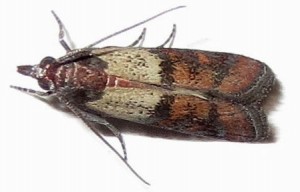 |
Dry food and plant materials | Groats, seeds, bulgur, rice, spices, semolina, cereals and more | Kitchen cabinets and other places where dry food is stored |
Overview of Different Moth Types and Egg-laying Locations
Moths That Attack Clothes and Textiles
These moths (including clothes moths, case-bearing clothes moths, and to some extent, the brown house moth) typically lay their eggs hidden within textiles. For example, clothes moths often lay their eggs in folds of clothing, pockets, under collars, etc. Case-bearing clothes moths tend to lay their eggs in fur, where the eggs are concealed among the hairs. You can read more about moths in clothing here.
Food Moths
Food moths (such as Indian meal moths and, to some extent, brown house moths and case-bearing clothes moths) lay their eggs in dry food items, like spices, grains, seeds, cereals, etc. Sometimes, it’s not immediately obvious that the food is infested, while in other cases, it’s more evident.
When you notice moths, it’s usually the larvae, their excrement, or their webs you’re seeing (and not the moth eggs!). The larvae also tend to move toward the surface of the food, making them visible sooner or later.

